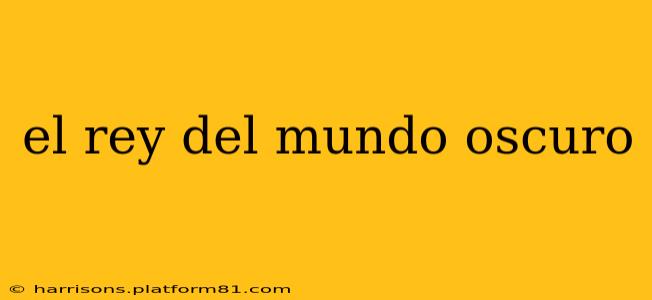El Rey del Mundo Oscuro: Unveiling the Mystery Behind the Name
The phrase "El Rey del Mundo Oscuro" (The King of the Dark World) evokes a sense of mystery and intrigue. While it doesn't refer to a single, established character like, say, Dracula, it's a title ripe with potential and evocative of a specific archetype found in numerous mythologies and fictional works. This article delves into the meaning, potential interpretations, and the symbolic power behind this captivating title.
What does "El Rey del Mundo Oscuro" symbolize?
The symbolic meaning of "El Rey del Mundo Oscuro" lies in its contrasting elements. "Rey" (King) signifies power, authority, and dominion. "Mundo" (World) represents the totality of existence, while "Oscuro" (Dark) adds a layer of complexity. The "dark" isn't necessarily evil; it can represent the unknown, the hidden, the subconscious, or even the unexplored depths of the human psyche. Therefore, "El Rey del Mundo Oscuro" can symbolize:
- A ruler of the unseen: This king holds sway over realms beyond the perception of ordinary individuals – the underworld, the spiritual world, or the hidden forces of nature.
- A master of secrets: He possesses knowledge and power concealed from the light, perhaps wielding dark magic or manipulating hidden agendas.
- An embodiment of primal forces: The darkness could represent untamed nature, primal instincts, or the chaotic aspects of existence, over which this king reigns supreme.
- A misunderstood figure: The darkness might also be a metaphor for misunderstood power, a ruler who operates outside conventional morality but perhaps with justifiable reasons.
Where have we seen this archetype before?
The "King of the Dark World" archetype appears frequently in various forms of storytelling:
- Mythology: Many cultures feature underworld deities or rulers of the night, embodying aspects of the "El Rey del Mundo Oscuro." Think of Hades in Greek mythology or the various deities associated with death and the afterlife in other pantheons.
- Fantasy Literature: Countless fantasy novels feature dark lords, necromancers, or powerful beings who control shadows and hidden realms, fitting the description perfectly.
- Horror Fiction: This archetype is often the central antagonist, a figure of immense power wielding dark magic and manipulating fear.
Is "El Rey del Mundo Oscuro" a specific character?
No, "El Rey del Mundo Oscuro" isn't a single, definitively established character. It's a title, a label that could be applied to various fictional figures or even used to create a new one. Its ambiguity allows for diverse interpretations and creative freedom.
How can I use "El Rey del Mundo Oscuro" in my creative writing?
The title offers a fantastic starting point for world-building and character development. Consider these possibilities:
- Antagonist: The king could be the primary villain, a powerful entity opposing the protagonist's goals.
- Protagonist: A morally grey character, whose methods are questionable but whose aims might be ultimately justifiable.
- Mysterious Figure: The king could remain a shadowy presence, influencing events from behind the scenes.
The key is to flesh out the specifics of the character or concept, defining their motivations, powers, and relationship to the broader narrative.
What are some examples of characters similar to "El Rey del Mundo Oscuro"?
Many fictional characters share similarities with the "El Rey del Mundo Oscuro" archetype. These include:
- Sauron (Lord of the Rings): A powerful dark lord who seeks to dominate Middle-earth.
- Darth Sidious (Star Wars): A manipulative and powerful Sith Lord who controls the galaxy from the shadows.
- Maleficent (Sleeping Beauty): A powerful sorceress driven by revenge.
These characters demonstrate the range of interpretations possible under the umbrella of "El Rey del Mundo Oscuro."
By exploring the rich symbolism and diverse interpretations of "El Rey del Mundo Oscuro," we can appreciate the power and flexibility of this evocative title. It serves as a springboard for creativity, allowing writers and artists to explore themes of power, darkness, and the complexities of human nature.
